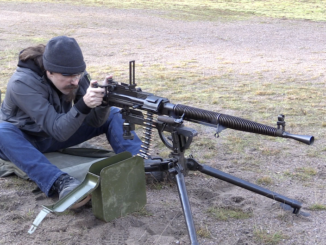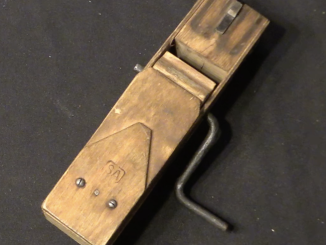The Jatimatic was a stockless PDW designed by Jari Timari, who co-owned Tampereen Asepaja Oy, a firearms company in Tampere Finland. The firm was founded in the early 1920s, making .22 biathlon rifles, sporterizing military surplus, and other gunsmithing work. In the late 70s he got the idea for a compact 9mm PDW with some unique climb-reducing features, and in 1980 it was introduced as the Jatimatic (JAli TImari). Only about 400 were made, as it was not adopted or purchased in large quantities by anyone (although it was tested by many, including the Finnish Border Guards).
The Jatimatic was made without a stock, instead using a shooting sling for stabilization. It used standard Swedish K magazines, and has a distinctly off-angle appearance. This was done to counteract muzzle climb, as the line of the barrel points directly back into the shooter’s hand. It also has an interesting safety built into the folding front grip – if the grip is closed, the bolt is locked in place.
Production ended in the late 1980s after “permit irregularities” and a robbery of a bunch of Jatimatics form the company premises. The rights to the design were sold to a new company called Golden Gun in 1994, and they attempted to reintroduce it as the GG-95 with a few improvements, but it was a rather complete flop. Its best achievement was getting into several major movies, including Cobra and Red Dawn.




So, I’m listening to this with half an ear, pretty much expecting Ian to go over the parallels with his favorite French SMG, the MAS-38. I don’t hear a word about that, so I listen a second time, paying more attention. First impression was correct…
So, now I’m wondering whether or not the people writing about the Jatimatic back when it was still the new hotness out of Finland were full of shiite about that detail, or if the parallels aren’t really there…
As I understood it, then, Jari Timari supposedly took inspiration from the MAS-38 and the “inclined plane” system was something he deliberately copied to help control recoil, etc., etc.. Now I’m wondering if this was BS, if Ian missed that detail, or if it’s another “thing” like the Blish Lock that really doesn’t work.
I always felt like this was one weapon that should have gotten a lot more attention than it did, but maybe that was the sheer “cool factor” of having come out of Finland and the way it presents in the pages of magazines and the minds of the reviewers. Supposedly, this is an extremely controllable weapon on full auto, and if I remember it right, Peter Kokalis was singing its praises everywhere. Somewhere, I’ve got the old articles about it saved, but I’d be hard-pressed to put my hands on them, today.
Consult https://patents.google.com/patent/US4569270A for technical description of said weapon
The downward bolt travel of the MAS 38 was supposed to delay bolt opening. Here we have an upward bolt travel supposedly to counter muzzle rise. I don’t see the former being the inspiration of the later.
“(…)I don’t see the former being the inspiration of the later.”
Both uses canted movement (barrel axis and axis of movement of moving parts are not parallel) which result in lessening of Rate-of-Fire. Both MAS-38 and Jatimatic were predated in that regard by The .30-18 Browning Autoloading Rifle https://www.historicalfirearms.info/post/174159467554/the-30-18-browning-autoloading-rifle-the-first
therefore 3 options might be considered: creator of Jatimatic was inspired by MAS-38, creator of Jatimatic was inspired by .30-18 Browning Autoloading Rifle, creator of Jatimatic was inspired by neither of these
There could be visual similarity but the principles at play are totally different.
MAS 38 increases friction by vectoring recoil thrust. It could had been lateral or upward but downward made more sense due to the drop of the stock.
Friction has not particular role in Jatimatic action. This one redirects bolt momentum to counter muzzle rise. And it must be upward to get the effect.
https://modernfirearms.net/en/submachine-guns/finland-submachine-guns/jati-matic-eng/ claims that The bolt recoils up an inclined plane at angle to the barrel, giving an element of braking to the bolt, and also resisting the upward movement of the barrel during the fire.
First half of that is not same as in MAS-38 and .30-18 Browning Autloading Rifle?
Replied to my own comment since Reply button is not avalaible on Daweo comment.
Bolt of MAS-38 (and .30-18 BAR) rubs against receiver at an angle so friction is increased compared to moving parallel, thus the braking effect.
Jatimatic bolt does not get extra friction from its incline move. Recoiling up an inclined plane simply means recoiling along a direction not parallel to the bore. Recoil springs and guides are aligned with the direction of travel. What’s happening is the bolt velocity is vectorised in 2 components: one upwards and one backwards, the later effectively reducing the recoil velocity.
This is more like those old fortress guns carriages recoiling along an inclined structure.
If I remember correctly, the gun was known for its ability to disassemble itself due to the strap being fastened onto the latch keeping the whole shebang in one piece.
Ouch!
So while the kung-fu guy at the other end tries to catch a 9mm bullet between his teeth
The firer has to contend with trying to catch the bolt between his teeth?
“Jatimatic: Finland’s Least Successful PDW(…) best achievement was getting into several major movies, including Cobra and Red Dawn.”
Which is still more Pelo submachine gun https://guns.fandom.com/wiki/Pelo_submachine_gun
So basically the Pelo was loaded like a Mannlicher-system bolt-action rifle, except through the side rather than down through the action.
Or even closer, a Krag-Jorgenson.
From the last photo, it appears that the feed system is based around an en bloc clip. I would assume that this would have to be removed manually before reloading.
Other than that, it seems to be mainly a reiteration of the Smith & Wesson Light Rifle of 1940 and/or the Vesely V42.
cheers
eon
“Or even closer, a Krag-Jorgenson.”
I assume that this is corrupted way of writing Krag–Jørgensen, if this does not hold true, ignore this answer entirely.
https://www.jaegerplatoon.net/ALMOST2.htm gives describe magazine in Pelo sub-machine gun as fixed and The magazine had lid, which was opened for inserting the cassette-like clips and then the lid was simply closed. Reloading was equally simple – just open the magazine lid, remove the ammunition empty clips and replace them with fully loaded ones before again closing the lid.
therefore it seems to be close in spirit to clip-loaded weapon whereby clip is required to proper functioning of weapon, like numerous Mannlicher rifles and unlike Krag–Jørgensen which was designed for loading 1 cartridge at time.
The 1970s prototype HK 36 with its 4.6x36mm cartridge had a gate-loaded non-detachable magazine loaded by cassettes of cartridges… I’d always wondered where in the world the German engineers at Oberndorf got that idea, and now I guess I know… From Pelo!
I’ve lived in New Hampshire for 10 years, and still haven’t been to Shooter’s Outpost. I need to fix that. Jim has managed to collect all the cool and rare stuff.
Maybe I’m just being cutesy, but the English mispronunciation (j as in “jam” rather than “y” as the Finns say it) would almost invariably be corrupted into “Jam-o-matic” by anyone dissing on the weapon.
This might have been mentioned before but i have heard it many times that the jatimatic did not come with a stock, i thought so too but today i came across a Finnish ASE magazine from 1994 that has an article about the jatimatic
https://imageshack.com/i/pmcxprzwj
in the picture above it says (my translation might not be perfect) ” for the american market there was a 16 inch barrel version with stock” the picture below says “there was also a folding stock version, though because of the exeptional firing characteristics the stock is not exactly needed”
thought this might interest somebody, if its old news then so be it
also the other pages of the article
https://imageshack.com/i/pobEVvfej
picture above is from the original 22lr target pistol that was the inspiration for jatimatic, named JAT
https://imageshack.com/i/pmpm8vpMj